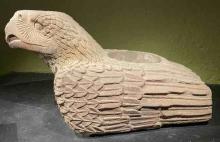cuauhtli (Mdz31r)
This iconographic example shows an eagle standing and looking to our left. Its feathers are varying shades of brown, its eye, beak, legs, and feet are yellow, and its claws are black. The beak is slightly open. The area around the one eye that we see (given that the bird is in profile, facing to our left) is gray. We provide this for comparisons with other eagles in the collection.
Stephanie Wood
We know from the Spanis-language gloss that this is an eagle, which is cuauhtli in Nahuatl, and it compares favorably with other representations of the eagle. The gloss also explains that this was a live eagle that was provided as a tribute item, in groups of four, more or less. Eagles that were provided in tributes were probably used for their feathers. "Feathers were used for ceremonial shields, and the garments of Aztec eagle warriors were completely covered in feathers. Feather work dressed idols and priests as well," according to Wikipedia.
Stephanie Wood
aguila viva / . q cada un tributo trayan / unas vezes rtes [tres?] / otras quatro / otras mas o menos
águila viva que cada un tributario traían unas veces tres(?) otras cuatro otras más o menos
Stephanie Wood
c. 1541, but by 1553 at the latest
eagles, feather, águilas, ave, aves, pájaro, pájaros, pluma, plumas, animals, animales
This stone sculpture of an eagle--in the form of a cuauhxicalli, a recipient for hearts--is located in the Templo Mayor in Mexico City. It was photographed by Rebecca Horn on 15 February 2023. Both eagles are shown in profile, facing toward the left. The delineation of the feathers is given special care in both the hieroglyph and the sculpture. The hood of the upper half of the beak is a diagnostic for identify eagles, not that they were the only birds of prey to have them.
cuauh(tli), eagle, https://nahuatl.wired-humanities.org/content/cuauhtli
Codex Mendoza, folio 31 recto, https://digital.bodleian.ox.ac.uk/objects/2fea788e-2aa2-4f08-b6d9-648c00..., image 72 of 188.
Original manuscript is held by the Bodleian Libraries, University of Oxford, MS. Arch. Selden. A. 1; used here with the UK Creative Commons, “Attribution-NonCommercial-ShareAlike 3.0 License” (CC-BY-NC-SA 3.0)



